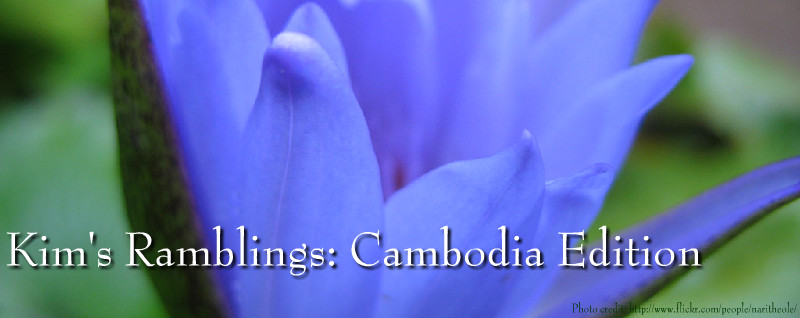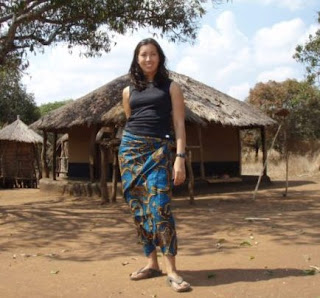I have arrived back in Lilongwe after my 12 day long Village stay. The purpose of my time in the village was to gain a better understanding of rural Malawian life. Small scale farmers are the main beneficiaries of TLC’s projects, so an understanding of the realities they face is important for me!
The village was located about an hour east of Lilongwe. It was 11km away from the nearest town and paved road. 34 people lived in the community I stayed in – 2 of whom speak some English.
For the first few days of my stay, Sabo, my father for the stay, was in Northern Malawi. As a result, the other English speaker, a woman named Ellis, became my go-to person.

Photo 1: Ellis and I
My Village
Photo 2: The village. On either side of a dirt path were mud huts and beyond those were a variety of storage structures (for maize and groundnuts mostly) and animal enclosures (chicken and pigeon coops, rabbit hutch, pig and goat pens), bathing stalls (with reed privacy shades and stone floors), and a latrine.

Photo 3: The village was located in a hilly area. Malawi has a densely populated rural area (as far as rural areas go anyway!) and this was evident where I was located as the countryside was dotted with many communities.

Photo 4: I stayed in Ellis’ hut. It is a simple mud hut with a thatched roof, divided into 2 rooms – a bedroom, and a sitting area. I stayed in the bedroom, sleeping on a reed mat placed on a metal bed frame – it was surprisingly not uncomfortable!

Photo 5: All of our cooking took place over open fire in the outdoor kitchen area. Most took place in the mud walled wind screen area. In this photo, I’m busily stirring sweet beer – a non alcoholic drink made from maize, served by the vat at weddings.
The Irrigation SiteThe village I stayed in was located at one of the sites TLC works in, a large stream diversion irrigation site.

Photo 6: The “garden” is a site that receives stream diversion irrigation (as described in my previous post – it is the same site in fact). The area is divided into 15m x 72m plots, rented out by various farmers. The types of crops grown there include paprika (peppers), maize, sweet potatoes, pumpkins, radish, Irish potatoes, cabbage, and a variety of other crops. Some, such as paprika, are sold, while others are consumed by the villages.

Photo 7: Sabo and I by the gardens.
Day to Day Life
Photo 8: A Meal
Both lunch and dinner consists of nsima served with a relish. Nsima is the Malawian staple food, made out of maize flour. Relish consists of any number of dishes consisting of meat (goat, chicken, or pigeon mostly), beans, vegetables (which include many different kinds of greens – pumpkin, radish, and sweet potato leaves to name a few; Chinese lettuce; cabbage; etc), tasty soya pieces (which really are very tasty!), or fish. In this case, the relish is simply egg and tomato. You roll the nsima into a little ball in your hand, make an indentation with your thumb, and then use it to scoop up the relish to eat.

Photo 9: Cooking Relish
Most cooking takes place over a fire, using three stones to prop up the pot.

Photo 10: School
The kids went to school from 7:30 – 12. The school was a 2 km walk away along a dirt path. Elementary school runs from standard 1 – 9, and high school consists of form 1 – 4.

Photo 11: Collecting firewood
Fire wood provides an important source of fuel, used for almost all cooking. The firewood is collected in the surrounding areas by the women. They go out and chop down small trees, leaving them to dry for a month before returning to gather the wood. The branches are lashed together using the bark of a certain type of tree, and then carried back on one’s head.

Photo 12: Football field
Boys playing football in a field located nearby. The ball used was constructed by the boys out of plastic bags and string.

Photo 13: Pounding Maize
Pounding maize is hard work (I have the blisters to prove it!). The dried maize kernels are pounded using a mortar and pestle to remove the outer layer of the kernels, done prior to grinding into flour.

Photo 14: Sifting corn
After pounding the maize, it has to be sifted to separate the kernels out. The kernels were then brought to the nearest maize mill, which was located a few kilometres away at the nearby army base, to be ground into flour for use in making nsima and porridge.
A Village WeddingDuring my stay I had the opportunity to attend a wedding at a nearby village.

Photo 15: Wedding – cooking nsima
Lots of food gets served at the wedding. A ridiculous quantity of nsima gets made, as well as relishes of different kinds of meat (no veggies available!).

Photo 16: Wedding – dancing
A common scene at a village wedding is a crowd gathered round a group of dancers. There are traditional men’s and women’s dances, both performed to the beat of a drum. Anyone may participate, and a large crowd develops to watch.
The bride and groom didn’t actually make their grand appearance until the end of the event. The festivities began at 1pm, and the bride and groom emerged at around 5:30 pm. They were fetched by a crowd of jubilant partygoers, but the couple themselves walked towards the rest of the guests with heads bowed, looking rather solemn. The groom wore a tuxedo, the bride wearing a white gown. They were led to a pair of chairs, which they were sat down on, with female relatives standing behind them. A few speeches were made, then presents and money were presented to the couple. My family left to return home before the end, so I’m not sure what happened at the end!
***
I'm now getting settled in to my new place in Lilongwe, and work is quite busy - but more on that next time!
 Photo 1: The house
Photo 1: The house Photo 2: The street
Photo 2: The street Photo 3: The sitting room
Photo 3: The sitting room
 Photos 4 &5: The kitchen
Photos 4 &5: The kitchen Photo 6: The shower room
Photo 6: The shower room Photo 7: My room
Photo 7: My room Photo 8: Out behind the house is an area that is essentially our garbage dump . . . The way that garbage is dealt with here is very different from the municipal waste, recycling, and compost collection I’m accustomed to back home! Not much waste ends up getting produced, but all the kitchen scraps, cardboard packaging, etc, is tossed in an area back there. The chickens from the neighbourhood come by to peck at what they can, and the rest gets burned on occasion.
Photo 8: Out behind the house is an area that is essentially our garbage dump . . . The way that garbage is dealt with here is very different from the municipal waste, recycling, and compost collection I’m accustomed to back home! Not much waste ends up getting produced, but all the kitchen scraps, cardboard packaging, etc, is tossed in an area back there. The chickens from the neighbourhood come by to peck at what they can, and the rest gets burned on occasion.

















